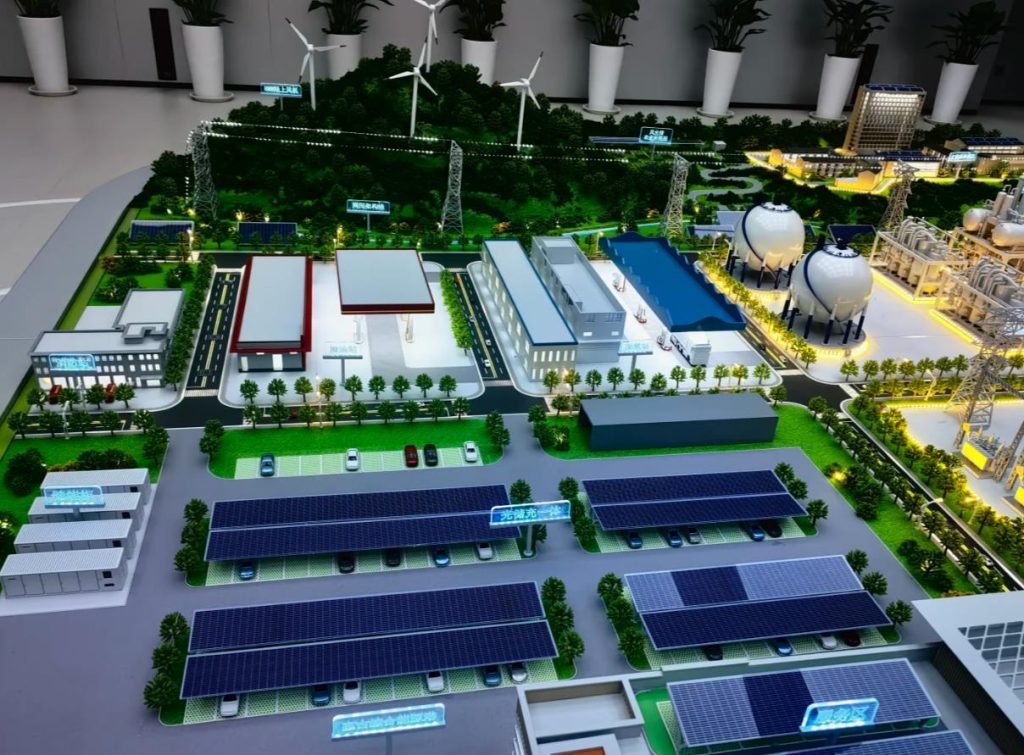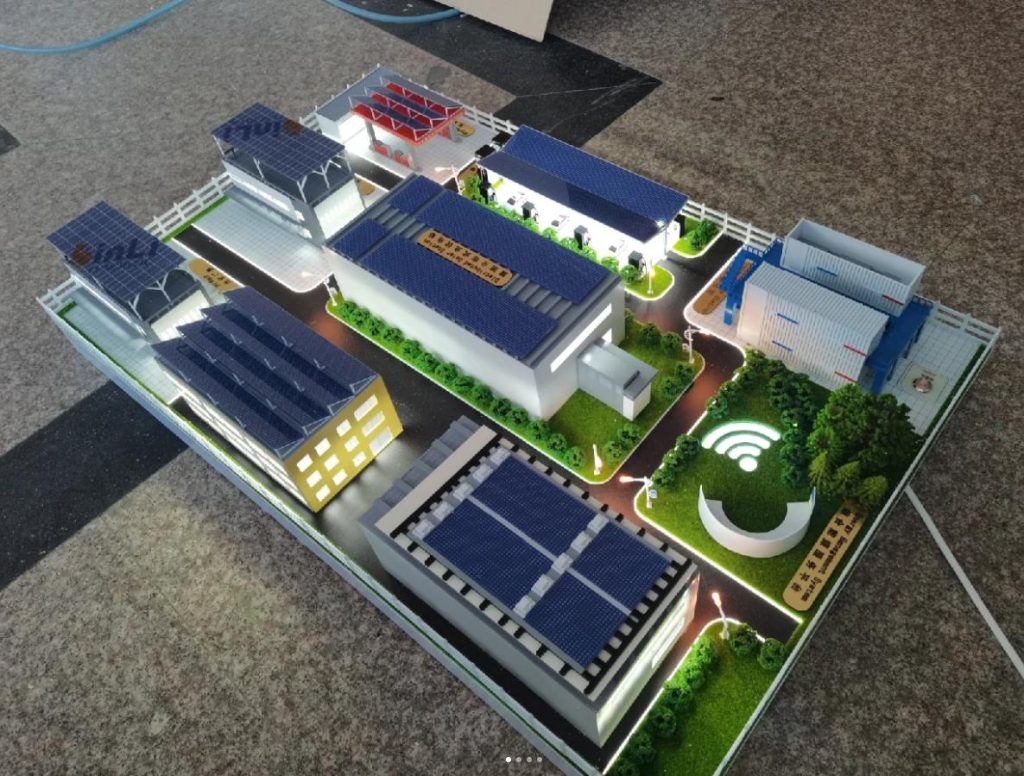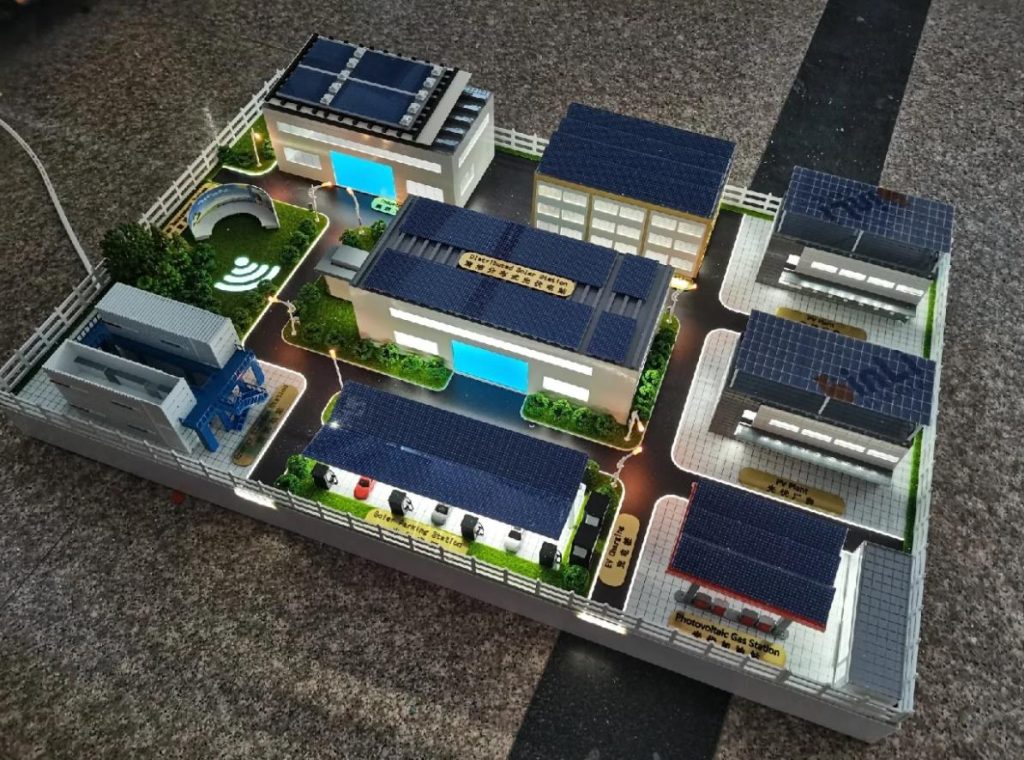Photovoltaic sand table model manufacturer
Case study of photovoltaic sand table model production
1、 Scene planning and material selection
Main frame: multi-layer high-density foam board is used to build the sand table base, and the terrain fluctuation of the site is simulated by stacking and cutting. The core buildings (such as photovoltaic plants and control rooms) use ABS engineering plastic laser engraved main structure to ensure strength and accuracy.
Photovoltaic modules:
Roof photovoltaic panels: 0.3mm thick blue acrylic panels are cut into rectangles, and the surface is hand drawn with silver markers to simulate solar panels with grid patterns;
Bracket system: Thin wire bent into inclined brackets, pasted on the roof of the building, with spacing proportionally restored to the real array layout.
Auxiliary materials:
Ground vegetation: cutting green spaces with nylon flocking cloth, mixing grass fibers of different lengths to simulate lawns and shrubs;
Roads and squares: Grey PVC board carved lane markings, surface sprayed with matte paint for anti slip;
Water landscape: Transparent resin poured pool, with blue gradient stickers pasted at the bottom to simulate water reflection.

2、 Construction and Facility Manufacturing Technology
Photovoltaic plant production:
Wall: ABS board laser engraved door and window contours, pasted with 0.1mm transparent film to simulate glass; Fill the wall joints with white soil, polish and spray light gray primer;
Roof: Layered pasting of blue acrylic photovoltaic panels, with fine gaps reserved between panels, embedded with silver metal strips to simulate junction boxes.
Supporting facilities:
Control room: Multiple layers of cardboard are stacked to create a three-dimensional sense of the building, and LED light strips are pasted on the front to simulate indoor lighting;
Energy storage equipment: Small plastic box sprayed silver gray, with heat dissipation hole patterns carved on the surface with a carving knife;
Charging pile: A 0.5mm copper wire is bent into the shape of a charging pile, and a red acrylic board is pasted on the top to simulate an indicator light.

3、 Surface treatment and color separation coating
Basic processing:
Use 600 grit sandpaper to polish the building components as a whole, and use sponge sandpaper to create circular arcs at the corners; Clean the transparent acrylic board with alcohol to remove oil and avoid paint peeling during coating.
Sand table base: the surface of foam board is covered with a layer of gypsum, and a gentle slope and flat ground are shaped with a scraper. After drying, light brown primer is sprayed to simulate the texture of the land.
Fine coloring:
Main building: The walls are sprayed with light gray matte paint, and the window frames are hand painted with black enamel paint; Brush silver paint on the edge of the photovoltaic panel to highlight the frame;
Equipment and pipelines: Energy storage tanks are sprayed in dark blue, pipelines are colored with yellow paint, and valves are marked with white dots;
Environmental color adjustment: Brush dark green powder on the edge of the green space, and use brown stain remover on both sides of the road to simulate natural stains.

4、 Integration of lighting and interactive effects
Photovoltaic simulation system:
Underneath the photovoltaic panel, there is a hidden micro LED light strip that lights up when connected to the battery box. The blue acrylic board is transparent and presents a “power generation” effect;
The control room window is embedded with warm yellow LED beads, simulating the working state in night mode.
Dynamic scene:
Open and close doors: The factory gate is connected by hinges, and when manually pushed or pulled, it drives the internal connecting rod, triggering the flashing lights of the “production line”;
Signage and signage: Yellow acrylic sheet laser engraved with words such as “photovoltaic area” and “energy storage station”, pasted in corresponding areas to enhance scene recognition.